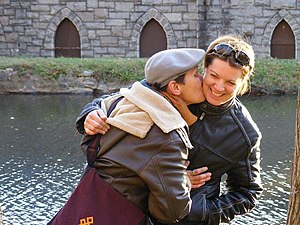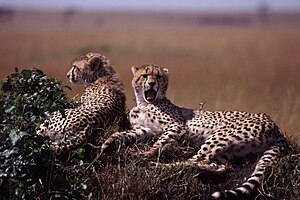Homosexual behavior has been documented in so many species that many scientists believe it is universal within the animal kingdom.
Last year a post of mine '11 'Gay' Animals' for Care2.com was my most viewed ever, being the most read for six weeks and attracting nearly 500 comments. When the site did a rejig last year I got dropped with many other writers so this follow up was never published. A friend picking up on the original inspired me to drag it out. So here's another 11 for you, starting with the most familiar: Homo Sapiens.
Homosexuality in humans has been documented for thousands of years, but we still have no final explanation as to why it occurs and how it develops.
We know that there are a number of features which distinguish homosexual human beings from heterosexuals. Studies have discovered some very odd distinctions -- like finger-length and hair swirl and even penis thickness. The existence of young children who are apparently gay or lesbian has come much more to the fore in recent years, as have transgendered children, suggesting that a "born this way" theory is on the right track.
Research has pointed at a number of possible biological causes with immunology currently a favorite because such traits are known to be influenced in utero. In any family, the second-born son is 33 percent more likely than the first to be gay, and the third is 33 percent more likely than the second, and so on, as though there is some sort of “maternal memory.”
Hypothetical mechanisms include an alteration in the flow of male hormones in the formation of boys and female hormones in the gestation of girls. Why? It could be germs, genes, maternal stress, and even allergy.
In this interview with the renowned evolutionist Richard Dawkins, Dawkins explains how evolutionists have a few theories for why human homosexual behavior would be favored in natural selection, they includes the 'gay uncle theory'. Here, gay members of a group help look after children, increasing the group's survival chances. This is also the case with many other species where non breeding members of a group help raise, for example, pups or other bees. Anthropologist Sarah B. Hrdy argues that for much of human history children were raised by groups, not just their parents alone.
Another is that a 'gay gene' we find now may have operated differently in another environment. An analogy would be how in hunter-gatherer times a gene that stores energy as fat quickly and efficiently during the rare times of abundant food may have been advantageous; genes that helped people fatten quickly would have been favored by selection. But now those same genes aren't so useful, because food is always abundant -- at least in the wealthy parts of the world -- and so people with these 'thrifty' genes are especially prone to diabetes and obesity.
Another theory is that a 'gay gene' could have a double function, just as the gene variant for sickle-cell anemia is maintained because it reduces the severity of malaria. It could be that the gene that causes men to become homosexual also makes women better at reproducing. Women with that gene would have more children than other women, and even though some of their sons become homosexuals who do not reproduce, they would still have enough heterosexual daughters to carry the genes on.
Studies of twins strongly suggest that such a gene does exist, but we are still to definitively idetify it.
Many societies, such as Polynesia's, have clear and approved roles for 'gay' sons and 'lesbian' daughters and throughout history priests and shamans have often been 'gay'. Richard Lippa, a psychologist from California State University, has found cross-cultural confirmation that gay men and lesbians tend to take up certain sorts of job and have common other stereotypes. This suggests that homosexuality evolved and persists in humans because it benefits groups or relatives, rather than individuals, like how in bonobo chimpanzee society, homosexual behavior has benefits at a group level by promoting social cohesion.
Biologists looking at the rest of the animal kingdom are trying to explain the apparent evolutionary advantages of homosexual behaviour. Researchers Nathan Bailey and Marlene Zuk provide a variety of possible answers in their short paper Same-Sex Sexual Behavior and Evolution (pdf). They give numerous examples of how same-sex sexuality appears to benefit various species.
After the jump read more about dolphins, elephants, flamingos, koalas and orang-utans.
Homosexual courtship between two males -- as demonstrated in the video -- is common in giraffes. It starts with foreplay, with both male giraffes rubbing their necks together and ear nibbling. Then on to both mounting and climax.
Homosexual relationships has been observed occuring with about 50% of all male giraffes, while only 1% of female giraffes have been observed having sex with other females.
Like lions, about two-thirds of male cheetahs have been observed forming 'coalitions'. These usually last for life. Pairs or trios will spend almost all their time together and frequently engage in affectionate and sometimes sexual behavior.
Pairs of males become extremely distressed when separated, continuously searching and calling loudly. Once they're reunited, sex may follow, including the 'stuttering' they do, which is like purring and associated with sexual excitement.
Pairs of males have sometimes been observed fostering cubs.
Much of the homosexual behavior observed in animals is between males. Not so in koalas.
Female koalas have been seen in captivity in groups of up to five at a time having sex. The behavior is yet to be observed in the wild but is seen in wild female koalas brought into captivity. It hasn't been observed in male koalas.
Why do they do it? Scientist's theories include that "the females do it to attract males; another is that it is simply hormonal, or that it is a stress reliever."

Homosexual behavior has been widely observed in orcas (killer whales).
Males have been watched spending entire afternoons engaged in courtship, rubbing and oral sex - using their orca penises, which are three feet long. They'll roll around with each other on the surface, splash, chase each other and make body contact. They've been seen with one swimming upside down underneath the other, making snout-genital contact. Then when the upper one surfaces to breathe the two then dive together in a double helix.
This behavior has been observed most often amongst adolescents - 12 - 25 years old - but some male orcas form lifelong "friendship pairs".

Penguins aren't the only birds where two captive males have found media fame after forming a family. Flamingos in captivity have done it too (though only females have been observed actually having sex).
Two males, Carlos and Fernando, who had been living at the Wildfowl and Wetlands Trust in England as a pair for six years, were seen trying to become chick-rearers by resorting to stealing eggs. Staff there recognized the pair's paternal instincts and gave them an abandoned egg which hatched and they raised the chick. Male flamingos can produce milk in their throats to feed a chick.
Such pairings aren't rare and don't just occur when there aren't enough females around.
Male dolphins throughout the world have been observed exhibiting extensive bisexual and, for some, exclusively homosexual behavior. The behavior includes dolphins engaging in 'nasal sex', using their blow holes: they're the only animals (other than humans) who are known to do this.
It has even been observed that when pods of bottlenose and Atlantic spotted male dolphins have met they will engage in cross-species homosexual behavior rather than fighting.
A long term study of bottlenose dolphins in Western Australia found groups of males which stayed together for many years and had complex social lives - one researcher described their lives as a "constant drama".
Sexual behavior has also been observed in female bottlenose, but at a much lower rate.
Another species of male dolphins, the boto or Amazon dolphin, have been observed having sex with each other in captivity.
The video is from Sea World in Florida, filmed in 2010 by a British tourist who says he was "happily watching the dolphins playing when I realized that that they weren't actually 'playing'."

Elephants in the wild are known for forming lifelong friendships between males, this can include homosexual behavior like courtship, including kissing, as well as mounting. A common relationship is of one older male with two younger ones.
About 45% of sexual encounters recorded amongst Asian elephants in captivity are same-sex.
In Poznan, Poland, the exclusively male preferences of one captive elephant, Ninio, got him in trouble with local anti-gay politicians. Said one Mr Grzes, from the right-wing Law and Justice party:
"We didn't pay 37 million zlotys (£7.6 million) for the largest elephant house in Europe to have a gay elephant live there."
Orang-utans are known to be amongst the most inventive species when it comes to sex. Tool users (like we humans) they'll make dildos out of wood and bark.
Male orang-utans have a unique ability when having sex with each other. They can retract their (small) penis, forming a cavity for another male to penetrate.
Studies in the wild in Sumatra, Indonesia, have found around one in ten male orangs exhibiting homosexual behavior with researchers describing two males they observed as "totally gay". They nicknamed the pair "Siegfried" and "Roy". The couple would bring back objects from the forest, like moss balls, to decorate the nest they shared.

Nemo is transgender!
Clown fish (aka 'Nemo') live in one anemone on a coral reef with a big female and a smaller male plus juveniles. But unlike what happens in the Disney film "Finding Nemo", where the 'mother' clown fish dies and the father and son go away on an adventure, on the real reef when the female dies the adult male changes into a female, and one of the juveniles becomes an adult male.

The role of homosexual activity in selection and evolutionary success has yet to be fully answered, but in one species it has been shown to increase reproductive success.
In the male flour beetle, they utilize gay sex to practice mating as well as rid themselves of "old, less effective" sperm. In transferring their sperm to another male it may end up with another female they've yet to meet, increasing their chances of reproducing and without the male beetle having to expend any energy having sex with the female.
Said researcher Sara Lewis:
"We could not believe these results when we first saw them, so we ran the experiment over and over again to make sure it was actually happening."







No comments:
Post a Comment